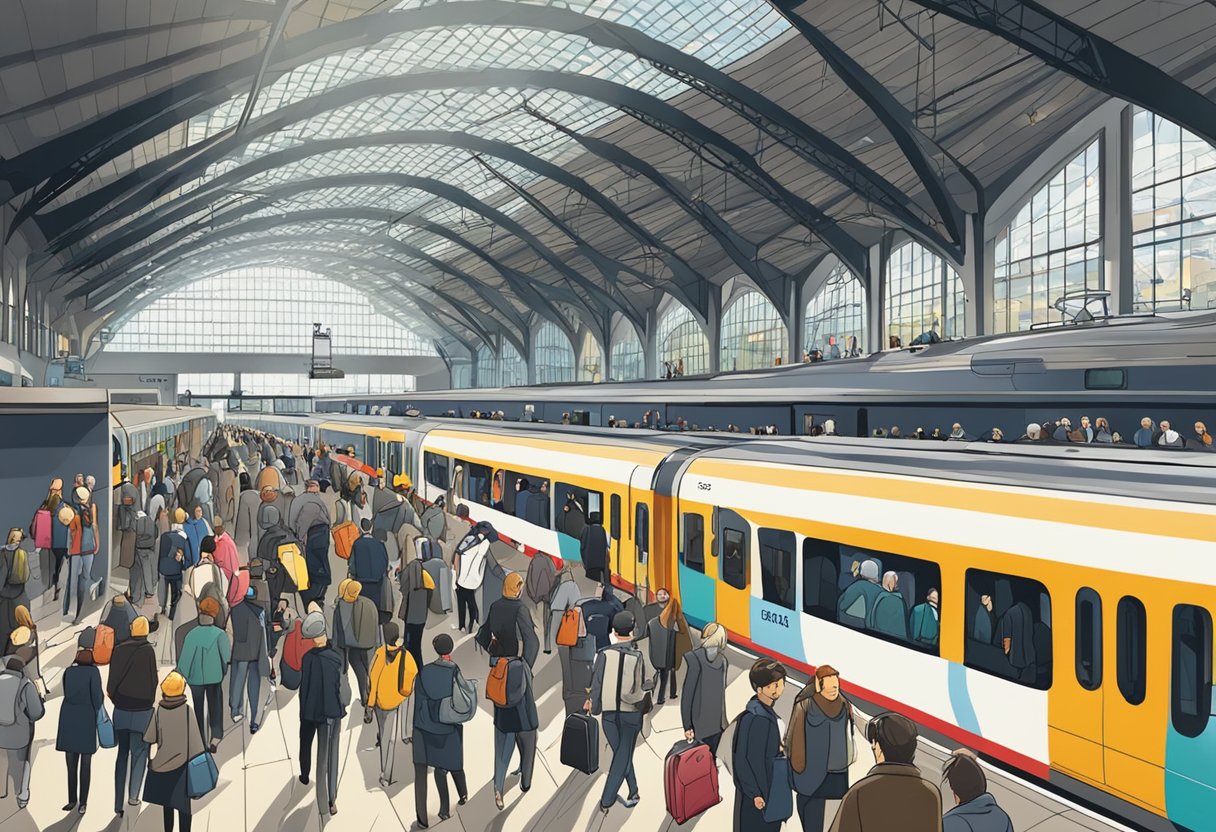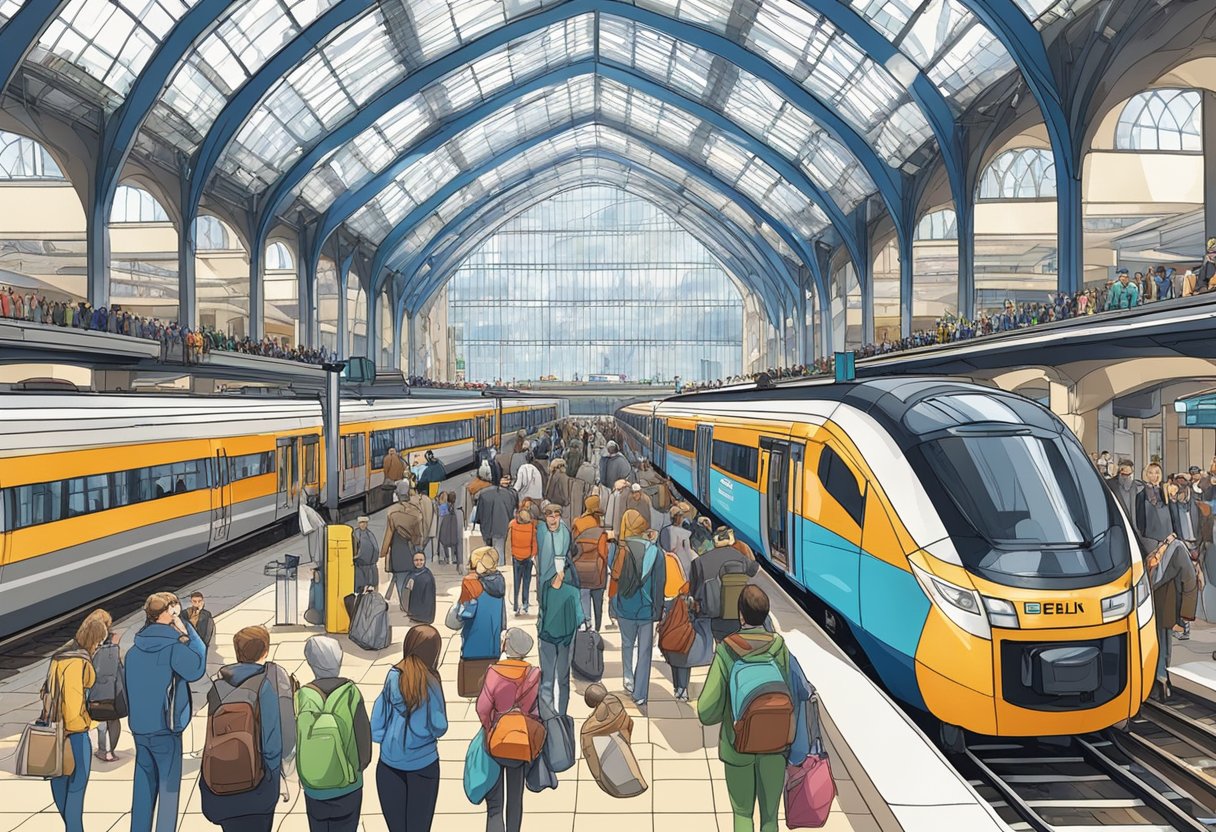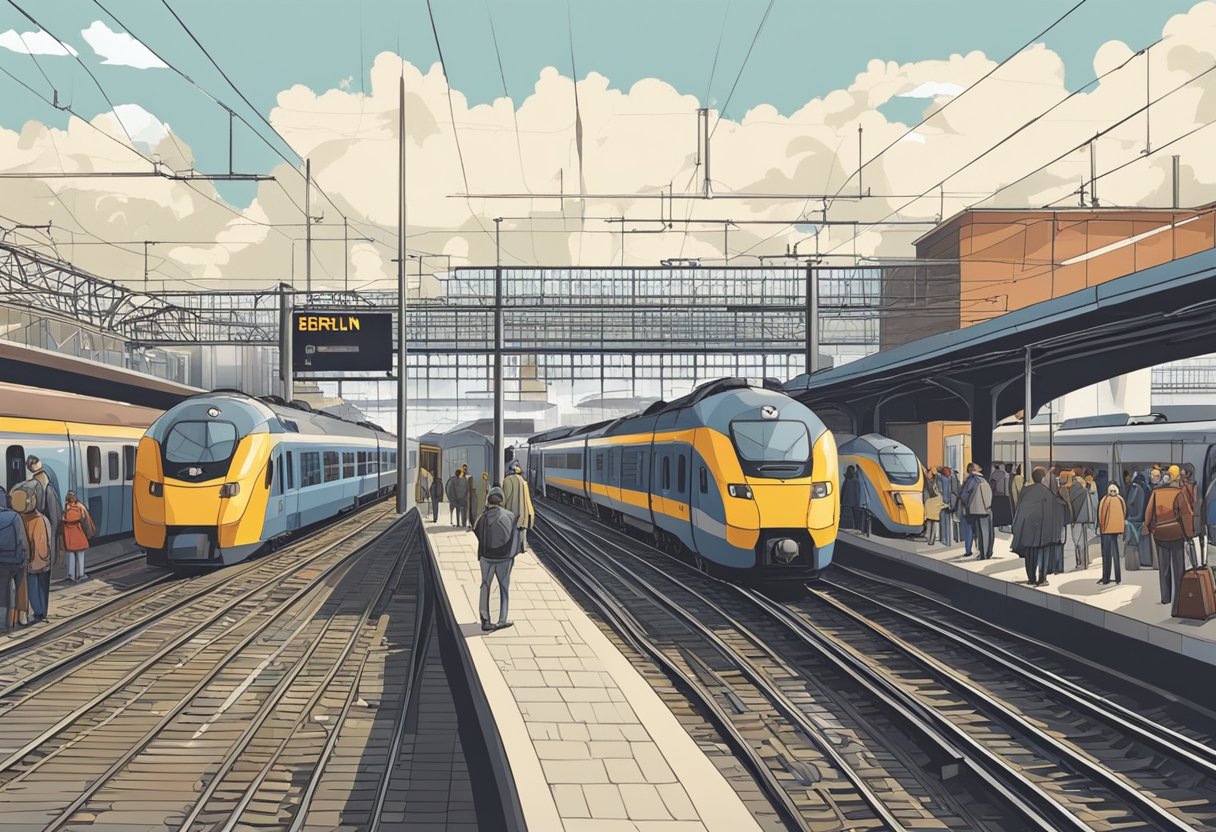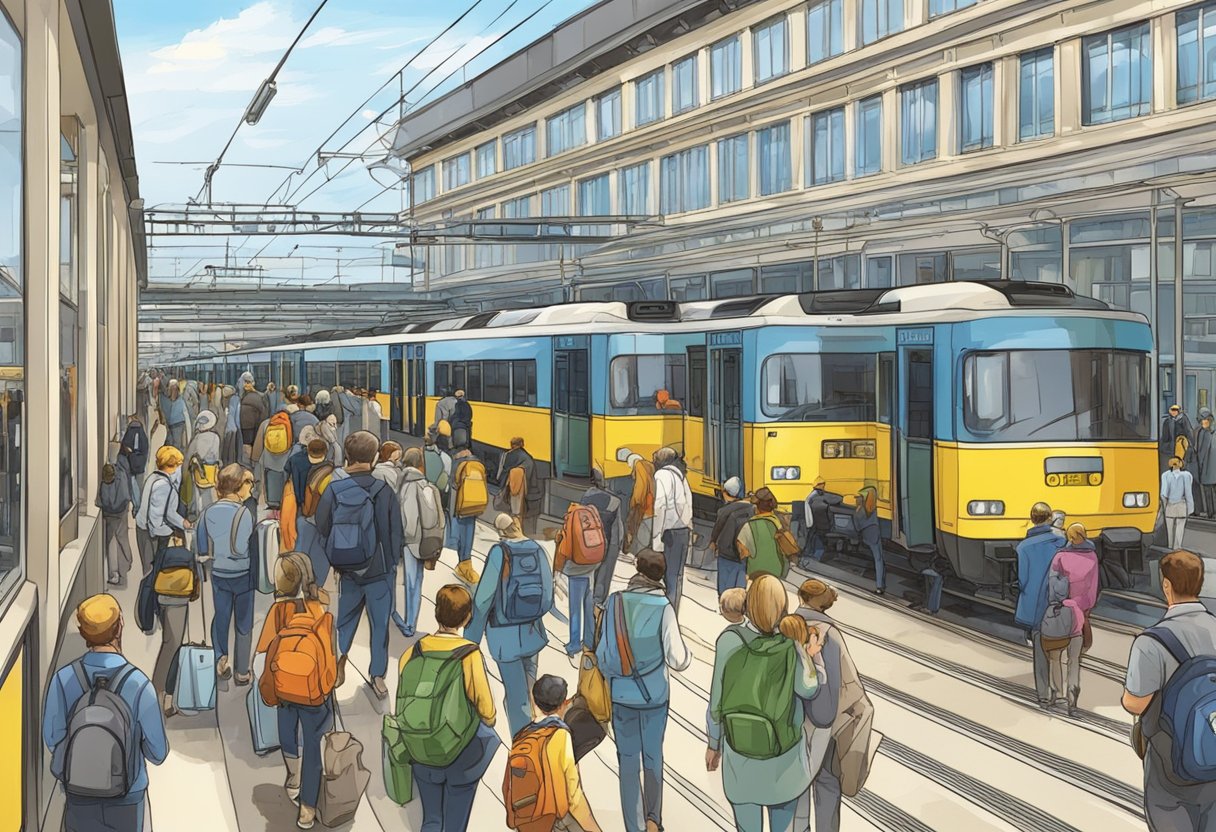Berlin Hauptbahnhof stands as a centerpiece of modern transportation in the heart of Germany’s capital. It’s not just a train station; it’s a symbol of efficiency and connectivity, marrying historical significance with contemporary brilliance.
Since its opening in 2006, the station has served as a vital hub for travelers, providing a juncture where local, regional, and international train services converge. Built on the grounds of the historic Lehrter Bahnhof, today’s station is a nod to the past and a gateway to the future.
Our understanding of the Berlin train station is rooted in its status as a core element of urban mobility. With its glass-and-steel edifice, the station is an architectural marvel that reflects Berlin’s forward-thinking ethos. It facilitates movement for countless passengers day in and day out, linking them to destinations citywide, nationwide, and beyond. The station’s intrinsic value comes not just from its function as a transit node but also from the services it provides, making travel seamless and integrated with the sprawling Berlin public transport system.
Ensuring travelers can navigate the complexities of modern transit, Berlin Central Station is a hive of activity with customer service centers, ticket offices, and shops catering to diverse needs. Whether we’re passing through the city or setting off on international adventures, the station is designed to support us with amenities and information. It’s more than a stop on a journey—it’s a place designed for transition, offering a clear and structured path from the heart of Berlin to countless other destinations.
History and Development
In this section, we’ll explore the significant historical events and the architectural evolution that have shaped Berlin’s central train station, from its destruction during World War II to its contemporary rebuild and modern operations.
World War II Influences
During World War II, the original Lehrter Bahnhof, which once stood as a symbol of Berlin’s railway prominence, suffered extensive damage. The station, an important junction since its opening in 1871, was reduced to rubble due to targeted air raids, reflecting the broader devastation inflicted upon Berlin’s transport infrastructure during the war.
Post-War Reconstruction
In the war’s aftermath, Berlin faced the colossal task of rebuilding its infrastructure. The Lehrter Bahnhof area lay in ruins for decades, serving as a poignant reminder of the war’s impact. It wasn’t until the fall of the Berlin Wall and the subsequent reunification of Germany that plans to reconstruct a new central station began to take shape, foreshadowing the emergence of the Berlin Hauptbahnhof.
Recent Developments
The year 2006 marked the inauguration of the contemporary Berlin Hauptbahnhof, a marvel of modern architecture designed by Meinhard von Gerkan. The station’s design is praised for its impressive glass hall that allows natural light to flood the interior, a stark contrast to the historical Lehrter Bahnhof. Today, the Hauptbahnhof serves as a vital hub, seamlessly integrating local, regional, and international travel, and exemplifies Germany’s commitment to preserving history while advancing state-of-the-art architecture.
Major Train Stations
Berlin boasts a comprehensive network of major train stations. These key hubs serve as the nexus of rail travel for both local commuters and international visitors, providing connectivity across the city and beyond.
Berlin Hauptbahnhof
Berlin Hauptbahnhof, also known as Berlin Central Station, is the city’s primary station and a contemporary architectural landmark. It opened in 2006 on the location of the historic Lehrter Bahnhof, and today it is one of Europe’s largest train stations. From this station, you can catch high-speed ICE trains to domestic and international destinations.
Ostbahnhof
The Ostbahnhof is one of Berlin’s most important railway stations for regional and long-distance travel, conveniently located in the central district. The station features a variety of shops and services, making it a well-equipped stop for travelers.
Gesundbrunnen
Located in the north of the city, Berlin Gesundbrunnen station is a key interchange within Berlin’s public transport system. In addition to regional and long-distance trains, it also connects to the S-Bahn and U-Bahn networks.
Spandau
The Spandau station, situated in the west of Berlin, offers access to regional and long-distance services. This station is an essential part of the city’s transport framework, especially for those traveling to and from the western suburbs and beyond.
Zoologischer Garten
Once the main railway hub for West Berlin, Zoologischer Garten station still holds significance due to its central location and connectivity to the U-Bahn and S-Bahn networks. The station is adjacent to the renowned Berlin Zoo and Aquarium.
Südkreuz
Südkreuz, located in the south of Berlin, offers significant services, including ICE, regional, and commuter trains. This station plays a pivotal role in Berlin’s rail infrastructure with connections to several major lines.
Lichtenberg
Situated in the eastern part of Berlin, Lichtenberg station is a hub for S-Bahn and regional trains. It is also a key point for trains to and from eastern Europe.
Schönefeld Airport BER
The railway station at Schönefeld Airport BER provides a direct link to Berlin Brandenburg Airport, making it crucial for accommodating the influx of travelers using the airport. The station ensures convenient access to both the city center and regional destinations.
Railway Services
Berlin Central Station serves as a pivotal hub for an extensive range of rail services, allowing for seamless transfers between long-distance, regional, and international trains. Our station boasts high-speed connections, regular regional trains, and direct links to major European cities.
ICE and Intercity
ICE (Intercity-Express) and Intercity trains are the backbone of our long-distance railway network. These trains offer rapid services to key German cities like Cologne, Munich, and Hamburg. The ICE technology ensures a swift and comfortable journey across the nation and to selected destinations such as Amsterdam and Paris.
Regional and S-Bahn
Our Regional trains and the S-Bahn network efficiently connect the city with the surrounding regions. The S7 and S9, for instance, are integral S-Bahn lines that serve many commuters and travellers daily. These routes provide essential links, such as the connection from central Berlin to Wünsdorf-Waldstadt.
International Connections
Boasting international connections, we provide direct services to various European destinations. Our trains connect travellers to cities like Prague, Warsaw, and beyond. With partnerships like FlixBus, we also expand our reach, offering journeys to further places like Poland, marrying convenience with international accessibility.
Public Transportation Integration
Berlin stands as an exemplary model when it comes to public transportation integration. We see an intricate mesh of U-Bahn and S-Bahn trains seamlessly connected with tram and bus services, allowing commuters to navigate the city with ease.
U-Bahn Network
The U-Bahn, Berlin’s metro system, includes the U5 line which is central to the network, connecting the east and west parts of the city. It intersects with various S-Bahn lines, ensuring that transfers are straightforward. Our U-Bahn network is complemented by the Ringbahn, the circular line that loops around the city center, providing further connectivity with other U-Bahn lines.
Tram and Bus Services
Berlin’s tram system, particularly lines such as M8, M10, and M5, integrate with our comprehensive network, offering extended services where the U-Bahn does not reach. Our buses, including the N20, N40, M41, and M85 routes, provide essential links to suburban areas and operate 24/7, ensuring round-the-clock connectivity. With tram and bus stops strategically located near U-Bahn and S-Bahn stations, the transition between different modes of transport is designed to be smooth and user-friendly.
Station Amenities and Services
At Berlin Central Station, we find a wide array of amenities and services meticulously designed to enhance the comfort and convenience of our travel experience. Whether it’s engaging in retail therapy or dining, or navigating the station with ease, we are well catered for.
Shopping and Dining
Within the main concourse, we’re met with an impressive selection of stores and eateries. From the latest fashion to essential travel items, the shopping experience resembles that of a small mall. For those of us with a penchant for food, the food options span from quick bites to sit-down meals, catering to various tastes and preferences.
- Stores: Variety of retailers, including bookstores and clothing outlets
- Cuisine: Array of dining options, from fast food to local specialties
Accessibility
We take pride in the station’s accessibility features. Escalators and elevators (aufzugs) link multiple levels, ensuring that the station is a barrier-free environment. Whether we’re arriving or departing, these features facilitate smooth movement across the station’s sprawling complex.
- Elevators: Connects all levels for easy access
- Escalators: Ensures swift movement throughout the station
Facilities
Our journey is further eased by a host of convenient facilities. Secure lockers are available for storing luggage, whilst ample seating in waiting areas allows for rest between connections.
- Lockers: Safe storage for luggage of various sizes
- Concourse Seating: Comfortable waiting areas throughout the station
Berlin Central Station represents a hub of activity and convenience, making our travels through this central node not just a necessity, but a pleasure.
Technical Aspects
We will examine the technical intricacies of Berlin Hauptbahnhof, showcasing how this marvel of modern engineering champions both infrastructural complexity and rigorous safety measures.
Infrastructure
Berlin Hauptbahnhof, located at Europaplatz, stands as a monumental hub in the city’s transport network. Our station’s infrastructure features multi-level track systems that cater to both regional Stadtbahn services and long-distance routes. With a staggeringly vast total area, the roof spans up to 66 meters to the east-west, providing shelter to numerous platforms and concourses beneath. The station is ingeniously designed to handle stress from heavy commuter traffic and has transformed into a central node that integrates seamlessly with Berlin’s central bus station (ZOB).
- Total roof area: Approximately 29,000 m²
- North-South: 8,000 m²
- East: 8,000 m²
- West: 13,000 m²
- Total building area: Around 70,000 m²
- Length of roofs East-West: 321 meters
The architectural prowess presents a station that is both a home for travellers and an emblem of Brandenburg’s commitment to high-capacity transit solutions.
Safety and Security
At Berlin Hauptbahnhof, our attention to safety and security is paramount. Cutting-edge surveillance systems are installed throughout the premises to ensure a secure environment for all our passengers. This sprawling transport nexus incorporates meticulous fire safety protocols, including regular drills and strategically placed exits designed for rapid evacuation. Moreover, we’ve implemented rigorous passenger-screening procedures at entry points to enhance security measures.
To meet the rigorous demands of safety and provide assurance to every person that walks through our doors, we constantly update our protocols and emergency preparedness plans, ensuring that anyone can count on us for a secure and reliable journey.
Traveler Information
In this section, we provide detailed information regarding tickets and pricing, along with operating hours, to ensure our passengers and visitors have a hassle-free experience at Berlin Train Station.
Tickets and Pricing
Tickets for a range of transportation options, including regional and local trains, are available at Berlin Hauptbahnhof. Deutsche Bahn operates the station, where tickets can be purchased from the service centers or from automated machines throughout the station. For convenience, customers can also buy tickets online via the Deutsche Bahn website.
- Standard Tickets: For single journeys within the city or region.
- Day Tickets: Unlimited travel within selected zones for one day.
- Group Tickets: Discounted tickets for small groups traveling together.
- Tourist Cards: Including the Berlin WelcomeCard for additional discounts on transportation and attractions.
Pricing is variable, depending on distance, chosen service, and ticket type. Discount fares are available for children, students, and seniors.
Operating Hours
Berlin Hauptbahnhof is designed to serve passengers at all hours. Our operating hours reflect the station’s commitment as a vital transportation hub:
- Station Hours: Open 24/7, including access to platforms and waiting areas.
- Service Center Hours: Available for customer service inquiries from early morning to late at night. For the most up-to-date hours, please refer to the official station page.
Remember, operating hours for retail stores and eateries within the station may vary, so it’s best to check specific details for these amenities if required outside the typical business hours.
Cultural Significance
Within Berlin’s vast network of transportation hubs, certain stations stand out for their cultural impact. Notably, Alexanderplatz has become more than a mere intersection of transit lines; it is a symbol of Berlin’s dynamic urban culture. This bustling square, surrounded by historical architecture and modern shops, is a testament to our city’s ability to blend the old with the new.
Moving to the banks of the Spree, the river that threads through Berlin’s cultural tapestry, its proximity to pivotal stations like Friedrichstraße enhances our understanding of these sites not just as transit points but as gathering places that have witnessed history unfold. The iconic river adds to the cultural ambiance, serving as a picturesque backdrop to the station’s comings and goings.
In the eastern part of the city lies Ostkreuz, a junction that mirrors the diversity found in the area’s rich, alternative scene. Here, we see Berlin’s past connecting with its present—a former industrial district now housing vibrant cultural venues. This interplay of time and space encapsulates our city’s ever-evolving spirit.
These stations, enveloped by Berlin’s history, stand as modern monuments to our city’s resilience and capacity for transformation. They don’t just move people; they move culture forward, acting as stages where daily life and historical moments coalesce. Through their continuing evolution, they remain pivotal chapters in the continuing story of Berlin.
Challenges and Future Plans
In examining the landscape of Berlin’s train systems, we observe a number of challenges that necessitate innovative strategies moving forward. Berlin Central Station, a monumental hub in the city’s public transportation network, has been grappling with the increasing demands of passenger and train traffic. Handling over 1,500 daily trains is a testament to its central role in our mobility infrastructure. Yet, scalability remains a concern as we anticipate future growth.
We’re also cognizant of the disruptions caused by construction works as Berlin expands and updates its transportation facilities. These disruptions are short-term pains for long-term gains—such as the introduction of new technology like maglev trains. Planning efforts are underway for a test track to explore the viability of magnetic-levitation propulsion, a technology promising to enhance the efficiency and speed of our train systems.
| Challenges | Future Plans |
|---|---|
| – Handling increased train and passenger load | – Constructing new lines and stations for increased capacity |
| – Construction disruptions | – Testing and potentially implementing maglev train technologies |
| – Aging infrastructure | – Renovating existing structures for modern requirements |
It’s our duty to ensure that the future of Berlin’s train services is not just about expansion, but about smart, sustainable development. We aim to adhere to strict deadlines and budgets to minimize impact on daily commutes.
We are steering towards a future where Berlin remains at the forefront of pioneering transportation solutions, driven by the commitment to connect communities and foster economic growth through reliable and cutting-edge train services.
Personal Experiences and Reviews
When visiting Berlin, we often find ourselves at the nexus of travel within the city: the Berlin Hauptbahnhof. As the main railway station, it’s not just a transit point; it’s also a place where we, alongside other travelers, experience the efficiency and complexity of German rail travel.
Our experiences at the station have been largely positive, with an appreciation for its modern architecture and the convenience offered by its multiple levels. From the top layer, where we catch some long-distance and regional trains, to Hauptbahnhof (Tief), the lowest level serving several S-Bahn lines, we’ve found navigating through the station to be a stress-free experience due to clear signage and information displays.
Visitor Reviews:
- Accessibility: We’ve noticed how Berlin Central Station caters to various mobility needs, making it accessible to all.
- Shopping & Dining: With numerous shops and eateries, we’ve never been at a loss for entertainment or nourishment during waits.
- Cleanliness: The station’s cleanliness is often mentioned in our conversations and stands out in our collective memory.
- Connectivity: We appreciate the connectivity the station provides. Direct links to other parts of the city and beyond have reduced our travel stress significantly.
Here’s how we’ve felt about specific amenities:
| Amenities | Our Experience |
|---|---|
| Wi-Fi | Reliable and often crucial for planning our journey |
| Seating Areas | Sufficient, although it can get crowded during peak hours |
| Restrooms | Generally clean, but availability can be a pain point during rush hours |
In our opinion, getting acquainted with the station before using it extensively is a solid piece of advice for any traveler to Berlin. Our familiarity has been beneficial, especially when we’ve needed to catch a connecting train or meet fellow travelers. Overall, the station plays an integral part in not just our own experiences, but also those of countless visitors to this vibrant city.
Economic and Environmental Impact
In our examination of the Berlin Train Station and its recent developments, we find both economic and environmental impacts playing crucial roles. With the introduction of more train services, Berlin anticipates an increase in economic activity due to improved connectivity. A report acknowledges that with an increasing number of trains, there can be triple or quadruple rises in the volume of travelers and goods passing through the town. Consequently, local businesses might flourish from the amplified flow of potential customers.
Economic Impact:
- Boost in local commerce
- Increased employment opportunities from the construction phases
- Long-term growth in tourism
Meanwhile, the environmental considerations are notably present in the expansion of train services. Rail travel, as a rule, shows a marked advantage in terms of emissions when compared to road transport. Our recognition of this is bolstered by ongoing discussions surrounding sustainable transport in Europe. We observe that upgrades to the Berlin Train Station incorporate more than just an increase in capacity; they actively tackle the environmental issues by improving the efficiency of the existing rail network. The International Union of Railways has conducted extensive research into the environmental impact of railway infrastructure, underscoring the benefits of such upgrades.
Environmental Impact:
- Reduced carbon footprint compared to other forms of transport
- Investments into modern, energy-efficient infrastructure
- Positive implications for urban planning with a focus on sustainability
Our stance remains clear as we discuss the balance between economic growth and environmental stewardship that Berlin Train Station’s developments aim to strike. We are mindful of how these upgrades not only serve the present but also pave the way for a more interconnected and greener Europe.





